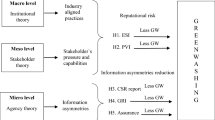Abstract
Public disclosure programs that collect and disseminate information about firms’ environmental performance are increasingly popular in both developed and developing countries. Yet little is known about whether they actually improve environmental performance, particularly in the latter setting. We use detailed plant-level survey data to evaluate the impact of India’s Green Rating Project (GRP) on the environmental performance of the country’s largest pulp and paper plants. We find that the GRP drove significant reductions in pollution loadings among dirty plants but not among cleaner ones. This result comports with statistical and anecdotal evaluations of similar disclosure programs. We also find that plants located in wealthier communities were more responsive to GRP ratings, as were single-plant firms.
Similar content being viewed by others
References
Arora S, Gangopadhayay S (1995) Toward a theoretical model of voluntary overcompliance. J Econ Behav Org 28: 289–309
Bennear L, Olmstead S (2008) The impacts of the “right to know”: information disclosure and the violation of drinking water standards. J Env Econ Manage 56(2): 117–130
Blackman A. (2010) Alternative pollution control policies in developing countries. Rev Environ Econ Policy 4(2): 234–253
Blackman A, Afsah S, Ratunanda D (2004) How does public disclosure work? Evidence from Indonesia’s PROPER program. Hum Ecol Rev 11(3): 235–246
Blackman A, Bannister GJ (1998) Community pressure and clean technology in the informal sector: an econometric analysis of the adoption of propane by traditional Mexican brickmakers. J Environ Econ Manage 35: 1–21
Bui L (2005) Public disclosure of private information as a tool for regulating emissions: firm-level responses by petroleum refineries to the toxics release inventory. Working paper 05-13, US Census Bureau
Centre for Science and Environment (2004) All about paper: the life cycle of the Indian pulp and paper industry. Centre for Science and Environment, New Delhi
Dasgupta S, Hong JH, Laplante B, Mamingi N (2005) Disclosure of environmental violations and stock market in the Republic of Korea. Ecol Econ 58: 759–777
Dasgupta S, Laplante B, Mamingi N (2001) Pollution and capital markets in developing countries. J Environ Econ Manage 42: 310–335
Dasgupta S, Wheeler D, Wang H (2007) Disclosure strategies for pollution control. In: Teitenberg T, Folmer H (eds) International yearbook of environmental and resource economics 2006/2007: a survey of current issues. Edward Elgar, Northampton
Delmas M, Montes-Sancho M, Shimshack J (2007) Information disclosure policies: evidence from the electricity industry. Working paper, Department of Economics, Tufts University
Foulon J, Lanoie P, Laplante B (2002) Incentives for pollution control: regulation or information?. J Environ Econ Manage 44: 169–187
García JH, Afsah S, Sterner T (2009) Which firms are more sensitive to public disclosure schemes for pollution control? Evidence from Indonesia’s PROPER program. Environ Resour Econ 42(2): 151–168
García JH, Sterner T, Afsah S (2007) Public disclosure of industrial pollution: the PROPER approach for Indonesia?. Environ Dev Econ 12: 739–756
Greene W (2002) Econometric analysis, 5th edn. Prentice Hall, Upper Saddle River
Greenstone M (2003) Estimating regulation-induced substitution: the effect of the clean air act on water and ground pollution. Am Econ Rev 93: 442–448
Gupta S, Goldar B (2005) Do stock markets penalize environment-unfriendly behavior? Evidence from India. Ecol Econ 52: 81–95
Kerret D, Gray GM (2007) What do we learn from emissions reporting? Analytical considerations and comparison of pollutant release and transfer registers in the United States, Canada, England, and Australia. Risk Anal 27(1): 203–223
Khanna M (2001) Economic analysis of non-mandatory approaches to environmental protection. J Econ Surv 15(3): 291–324
Khanna M, Anton WRQ (2002) Corporate environmental management: regulatory and market-based pressures. Land Econ 78(4): 539–558
Khanna M, Quimio W, Bojilova D (1998) Toxic release information: a policy tool for environmental information. J Environ Econ Manage 36: 243–266
Koehler D, Spengler J (2007) The toxic release inventory: fact or fiction? A case study of the primary aluminum industry. J Environ Manage 85(2): 296–307
Konar S, Cohen M (1996) Information as regulation: the effect of community right to know laws on toxic emissions. J Environ Econ Manage 32: 109–124
Laplante B, Lanoie P (1994) Market response to environmental incidents in Canada. Southern Econ J 60: 657–672
Lyon TP, Maxwell JW (2002) Voluntary approaches to environmental regulation: a survey. In: Frazini M, Nicita A (eds) Economic institutions and environmental policy. Ashgate Publishing, Aldershot and Hamsphire
Maxwell JW, Lyon TP, Hackett SC (2000) Self-regulation and social welfare: the political economy of corporate environmentalism. J Law Econ 43(2): 583–618
Pargal S, Wheeler D (1996) Informal regulation of industrial pollution in developing countries. J Polit Econ 104: 1314–1327
Sam A, Innes R (2006) Voluntary pollution reductions and the enforcement of environmental law: an empirical study of the 33/50 program. Working paper, Department of Agricultural, Environmental, and Development Economics, Ohio State University, Columbus
Schumacher K, Sathaye J (1999) India’s pulp and paper industry: productivity and energy efficiency. Working paper 41843, Lawrence Berkeley National Laboratories
Tietenberg T (1998) Disclosure strategies for pollution control. Environ Resour Econ 11: 587–602
Videras J, Alberini A (2000) The appeal of voluntary environmental programs: which firms participate and why?. Contemp Econ Policy 18(4): 449–461
Vidovic M, Khanna N (2007) Can voluntary pollution control programs fulfill their promises? Further evidence from EPA’s 33/50 program. J Environ Econ Manage 53: 180–195
Wang H, Bi J, Wheeler D, Wang J, Cao D, Lu G, Wang Y (2004) Environmental performance rating and disclosure: China’s GreenWatch program. J Environ Manage 71(2): 123–133
Wooldridge J (2002) Econometric analysis of cross section and panel data. MIT Press, Cambridge
World Bank: (1999) Greening industry: new roles for communities, markets, and governments. Oxford University Press, New York
Author information
Authors and Affiliations
Corresponding author
Additional information
This research was undertaken while Nicholas Powers was a doctoral student at the University of Michigan.
Rights and permissions
About this article
Cite this article
Powers, N., Blackman, A., Lyon, T.P. et al. Does Disclosure Reduce Pollution? Evidence from India’s Green Rating Project. Environ Resource Econ 50, 131–155 (2011). https://doi.org/10.1007/s10640-011-9465-y
Accepted:
Published:
Issue Date:
DOI: https://doi.org/10.1007/s10640-011-9465-y




